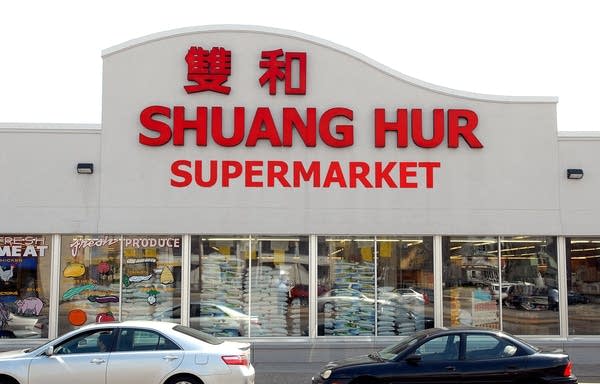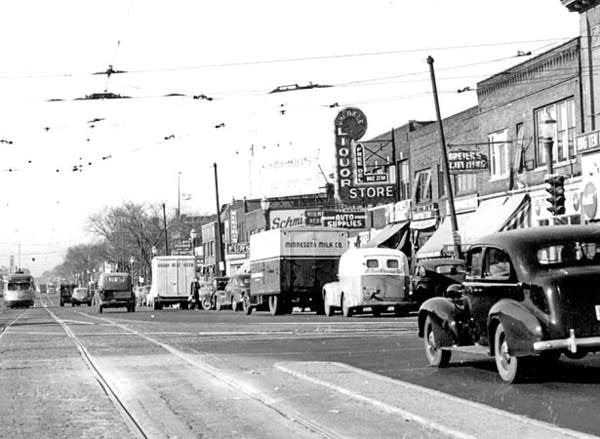Immigrants always welcome
Go Deeper.
Create an account or log in to save stories.
Like this?
Thanks for liking this story! We have added it to a list of your favorite stories.

The east end of University Ave. is Frogtown's main drag. At Shuang Hur Supermarket, one of Frogtown's biggest attractions, owner Daisy Haung loves to show off her produce section.
"This is Mao Qwa.They are melon, but they are Asian-style melon. They are like cucumber," said Haung. "Some of these things, like bamboo, they are a very huge part of our diet. There are many, there are thousands and thousands of types of bamboo out there. Some are edible and some are not edible but these are like cucumbers."

"Galanga, lime leaves, we sell a lot of it," she said. "Cub Foods and other mainstream stores might be trying it a little bit and carrying some things, but people do need to come back to their Asian Shuang Hur store."
Haung opened the store with her husband and family about five years ago. It's their second location. They opened their first on Eat Street in Minneapolis two decades ago. Haung says the diversity of University Ave. was a big draw.
Turn Up Your Support
MPR News helps you turn down the noise and build shared understanding. Turn up your support for this public resource and keep trusted journalism accessible to all.
Shopper Mai, who didn't want to give her last name, says she comes to find her favorite tropical fruits and vegetables.
"I come from Vietnam. I find a lot of things that I miss in my homeland, like those fruits, tropical fruits and yam, different kinds of yam. A lot of things that we miss and we couldn't find in American grocery stores," Mai said.

Today, Frogtown's ethnic mix includes immigrants from across Asia, Africa and Latin America. And Frogtown has always been a melting pot.
It was settled in the mid to late 1800s, sprouting up around the railroads and the industries that served them. Jobs with the St. Paul and Pacific Railroad, now called Burlington Northern, attracted scores of immigrants from across Europe.
By the time the streetcar lines were laid down around the turn of the century, Frogtown was a thriving working class community with a bustling commercial district.
But as the industry began to disappear in the 1970s, Frogtown fell into deep decline. The area soon became notorious for drugs, crime and prostitution.

Into this downward spiral came new immigrants from Southeast Asia. Chief among them were Hmong refugees escaping violence in Laos, Thailand and elsewhere, who took advantage of Frogtown's cheap housing.
They established businesses, and with them, set off a new wave of immigration to University Ave. that continues to this day. Many observers credit these immigrant businesses with saving the east end of University Ave.
Daisy Haung worries that construction of the light rail could destroy the mom-and-pop businesses that give University Ave. its special flavor.
"I anticipate that it will probably take a year and a half, and those people will be hurt the most," Haung said. "There are some beautiful, really good restaurants servicing the community and they are really really busy. We really need to protect those people, and those people need to stay. Because, without them, University wouldn't be the same."

Haung is confident that her business will survive, but she says it's in every University Ave. business owner's interest to join together to help the smaller businesses make it through.
Historian Brian Horrigan, a curator at the Minnesota Historical Society and a board member of the non-profit preservation group Historic St. Paul, says it will be an uphill battle.
He says displacement is not a question of whether -- but of how.
"It's tempting to look at the transportation itself as infrastructure and something linear. But it ripples out so broadly," said Horrigan. "It's quite tempting to see these things as development opportunities and things getting torn down and building upscale condominium housing, such as is going on close to the Greenway in Minneapolis, close to the light rail in Minneapolis. It's something to be concerned about and be watching for."

Horrigan says community residents and the city and state need to start now to protect the existing neighborhoods along University Ave.
Others are less hopeful that displacement can be prevented at all.
The $909.1 million plan calls for an 11-mile route between Minneapolis and St. Paul. On the eastern end of the avenue, the stations are set about a mile apart.
Some residents worry that the placement is too far for riders to walk, especially with the significant cuts to bus service called for by the plan.
Activists are calling for three additional stations and restored bus service. Met Council officials say including those stops will put the plan over budget, and disqualify it for federal matching money. They say without the federal funding, the project is impossible.
[image]
Instead, the plan calls for building the infrastructure of the three stations, so they can be built out later.
That answer doesn't satisfy Veronica Burt, a community organizer with the Aurora St. Anthony Neighborhood Development Corp. In addition to more stations and restored bus service, she'd like to see protections for existing housing and businesses.
Burt says the plan for Central Corridor should set aside a certain percentage of construction jobs for neighborhood residents, and require future development to include affordable housing. If those kinds of guarantees were in place, Burt says more people might get behind the project.
"I think that sends a message to the community that this is a project that can also be helpful to your needs and your community development aspirations," said Burt. "But evidently that is not the message we are getting. So, hence, a lot of people see that a project like this is for somebody else and not them."

For some in St. Paul, the proposal brings back bad memories of another major transportation project.
"What we need is to invest more money in good new roads instead of spending so much patching up worn out ones," went a classic newsreel film.
During the mid-20th century highway boom that swept the nation, Minnesota began constructing Interstate 94 in the 1950s.
"This is the American dream of freedom on wheels. Our highway engineers know the way. Freedom of the road is as old as the first man and as new as this moment," the newsreel continued.
While Prospect Park residents on the west end, were able to protect most of their neighborhood from destruction, this part of St. Paul wasn't so lucky.
Many longtime St. Paul residents remember that time vividly.
"Like it was yesterday," said Yusef Mgeni as he sat at a table at the Golden Thyme coffee shop on Selby.
Mgeni recalled being a child when the government began seizing thousands of homes and businesses to make way for I-94.
"The decision was made. It was parachuted into this community. And the next thing we knew was that senior citizens, people who had worked all their lives to purchase their homes, were basically being told to get out," said Mgeni. "And then the bulldozers would come and knock the houses down. It just devastated people. They were absolutely crushed. They felt like they'd been violated, and I feel like our community was violated."
The new highway cut down Rondo Ave., the commercial core of St. Paul's African American business district.
David Brooks' family still owns and operates the Brooks Funeral Home, an original Rondo business started in 1929. The funeral home was forced to relocate for I-94 and now sits on Concordia Ave. near Victoria St.
"I remember Rondo when it existed, when the carts were drawn by horses -- milk carts, rag man, ice man -- and the horses would draw those carriages up and down Rondo delivering their different goods," recalled Brooks.
"Everybody was everybody's friend because everybody spoke to everybody," Brooks continued. "Everybody said hello whether you knew them or not, and people always had their doors open so you could say, 'Could I borrow a cup of sugar?' It was family, it was community, everything."
Brooks says even though his family business prospered after the highway came through, it's still upsetting to remember the pain the community suffered when Rondo disappeared.
Even critics admit that Rondo and Central Corridor are very different projects. The light rail line isn't expected to destroy homes or businesses.
But the fear is that -- like Rondo -- LRT could ultimately disrupt the neighborhoods in its path, and alter or destroy the diversity of this historic avenue.
"There is something about a freeway, and something about big projects, that obliterates not only the landscape -- but obliterates memory, as well," said historian Brian Horrigan. "And that's what is tragic, because you lose those really important ties to the past."
Community organizer Carol Swenson hopes that if residents and business owners are involved in the planning process, the character of University Ave. can and will be preserved.
"The thing will be built, and they will be off building another one someplace else. And then the community and the people are left behind to deal with it and work with it," said Swenson. "They have to do that. If they can be involved in the process and have ownership along the way, it has a lot stronger opportunity for success."







